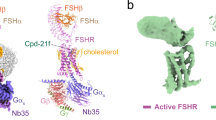Abstract
The follicle-stimulating hormone receptor (FSHR) large extracellular domain suggests that interaction of ligand with receptor is likely to be complex. Residues 265–296 of the FSHR are part of a sequence primarily nonhomologous with other glycoprotein hormone receptors. A reasonable hypothesis is that this sequence of the FSHR plays a role in binding FSH. Flow cytometry studies of this region revealed that antibody x179 against peptide R265–S296 bins to humans FSHR expressed by CHO cells and can be competed against by preincubating the cells with hFSH. These results suggested that the region corresponding to residues 265–296 in the extracellular domain of the FSHR is involved in binding to hormone. To test this hypothesis 10 scanning alanine mutants of rFSH at the 265–296 epitope were generated, and the binding characteristics of these mutants were studied. Their affinity constants for 125I-hFSH did not deviate greatly from that of wild-type FSHR, in which some mutants exhibited an approximately two- to threefold reduction in K a compared to wild-type receptor, and no mutation abolished signal transduction. These results lead to rejection of the hypothesis that this region contains residues critical for conveying hormone specificity and receptor-dependent hormone action.
Similar content being viewed by others
References
Reichert, L. E. and Dattatreyamurty, B (1989). Biol. Reprod. 40, 13–26.
Varrault, A., Pena, M. S., Goldsmith, P. K., Mithal, A., Brown, E. M., and Spiegel, A. M (1995). Endocrinology 136, 4390–4396.
Braun, T., Schofield, P. R., and Sprengel, R. (1991). EMBO J. 10, 1885–1890.
Davis, D., Liu, X., and Segaloff, D. L (1995). Mol. Endocrinol 9, 159–170.
Osuga, Y., Kudo, M., Kaipia, A., Kobilka, B., and Hsueh, A. J. (1997). Mol. Endocrinol 11, 1659–1668.
Sairam, M. R., Jiang, L. G., Yarney, T. A., and Khan, H. (1997). Mol. Reprod. Dev 48, 471–479.
Roche, P. C., Ryan, R. J.,, and McCormick, D. J (1992). Endocrinology 131, 268–274.
Atassi, M. Z., Manshouri, T., and Sakata, S. (1991). Proc. Natl. Acad. Sci. USA 88, 3613–3617.
Sharma, S. C. and Catterall, J. F (1995). Mol. Cell. Endocrinol. 115, 87–93.
Dattatreyamurty, B. and Reichert, L. E. Jr. (1992). Mol. Cell. Endocrinol. 87, 9–17.
Dattatreyamurty, B. and Reichert, L. E. Jr. (1993) Endocrinology 133, 1593–1601.
Quintana, J., Hipken, R. W., and Ascoli, M. (1993). Endocrinology 133, 2098–2104.
Wu, C., Narayan, P., and Puett, D (1996). J. Biol. Chem. 271, 31,638–31,642.
Liu, X., Depasquale, J. A., Griswold, M. D., and Dias, J. A. (1994). Endocrinology 135, 682–691.
Munson, P. J. and Rodbard, D. (1980). Analyt. Biochem 107, 220–239.
Simoni, M., Gromoll, J., and Nieschlag, E. (1997). Endocr. Rev. 18, 739–773.
Salesse, R., Remy, J. J., Levin, J. M., Jallal, B., and Garnier, J. (1991). Biochimie 73, 109–120.
Seetharamaiah, G. S., Kurosky, A., Desai, R. K., Dallas, J. S., and Prabhakar, B. S. (1994). Endocrinology 134, 549–554.
Wells, J. A. (1991). Methods Enzymol. 202, 390–410.
Pearce, K. H., Ultsch, M., Kelley, R. F., de Vos, A. M., and Wells, J. A. (1996). Biochemistry 35, 10,300–10,307.
Clackson, T. and Wells, J. A. (1995). Science 267, 383–386.
Cunningham, B. C. and Wells, J. A. (1993). J. Mol. Biol. 234, 554–563.
Niu, W., Zhou, Y., Dong, Q., Ebright, Y. W., and Ebright, R. H. (1994). J. Mol. Biol 243, 595–602.
Weiner, R. S.., Andersen, T. T.., and Dias, J. A. (1990). Endocrinology 127, 573–579.
Kelton, C. A., Cheng, S. V. Y.., Nugent, N. P., Schweichkhardt, R. L., Rosenthal, J. L., Overton, S. A., Wands, G. D., Kuzeja, J. B., Luchette, C. A., and Chappel, S. C. (1992). Mol. Cell. Endocrinol. 89, 141–151.
Roos, P. and Gemzell, C. A. (1964). Biochim. Biophys. Acta 82, 218–220.
Sanger, F., Nicklen, S., and Coulson, A. R. (1977). Proc. Natl. Acad. Sci. USA 74, 5463–5467.
Author information
Authors and Affiliations
Corresponding author
Rights and permissions
About this article
Cite this article
Liu, X., Butterstein, G.M., Lindau-Shepard, B. et al. A pollicle-stimulating hormone receptor ecto-domain epitope that is a target for receptor immunoneutralization yet does not affect ligand contact and activation. Endocr 13, 361–367 (2000). https://doi.org/10.1385/ENDO:13:3:361
Received:
Revised:
Accepted:
Issue Date:
DOI: https://doi.org/10.1385/ENDO:13:3:361




